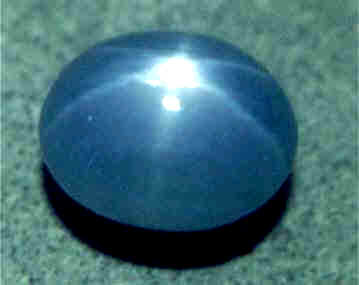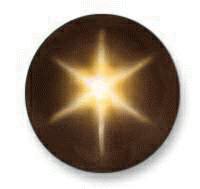

images taken from http://www.thaigem.com
Asterias
| Figure 4.1 - Examples of Star-Sapphires (Asterias) |
  |
|
images taken from http://www.thaigem.com |
Asterias, or star-stones, are sapphires or rubies with a six-pointed star of light seeming to come from inside the stone (figure 4.1). These curious and beautiful features are the result of light reflecting off the tiny inclusions of needle-like rutile (TiO2) crystals.
If these rutile needles are arranged in three sets at 120o to each other, and the gem is cut into a cabochon (dome - see figure 4.1) so that the base of it is parallel to the plane of the needles, the asterism will be seen. The crystal needles must be arranged so that they are parallel to the faces of the first order crystal prism.
While a six-pointed star is the most common, it is also possible to get single 'cats-eye' corundum crystals. These occur where there is only one set of parallel needles. Only one ray of light will therefore be seen.
Similarly, some very rare twelve-pointed stars are also known. These arise when an additional three sets of rutile crystals are present. These are parallel to the faces of the second order prism (at 30o to the faces of the first order prism).
Synthesis
The process for star-sapphire growth is based on the Verneuil Technique, with a notable difference. 0.1 - 0.3 percent TiO2 is added to the feed powder and a clear boule of blue sapphire is made, as if the titanium dioxide were not present (ie no asterism). This boule is then heated, typically to 1300oC for 24 hours. At this temperature, the titanium dioxide is no longer soluble, and precipitates in the form of needle-like crystals of rutile, in the arrangement necessary for the formation of the asterisms (described above). This process has one major drawback in that the titanium has a tendency to migrate to the outside surface of the growing boule. The sapphires produced therefore tend to have incomplete stars, with uneven rays. This problem was solved by a modification of the boule formation process. By cycling the oxygen flow rate in the torch, the temperature of the growth system is varied. A thin layer of the growing boule is solidified before the next layer is added. This ensures that there is no run-off of the titanium to the outer surfaces.
|
Home ║ Introduction ║ Corundum ║ Colour ║ Synthetic Sapphires ║ Asterias ║ Sapphires of Interest ║ Glossary ║ Links |